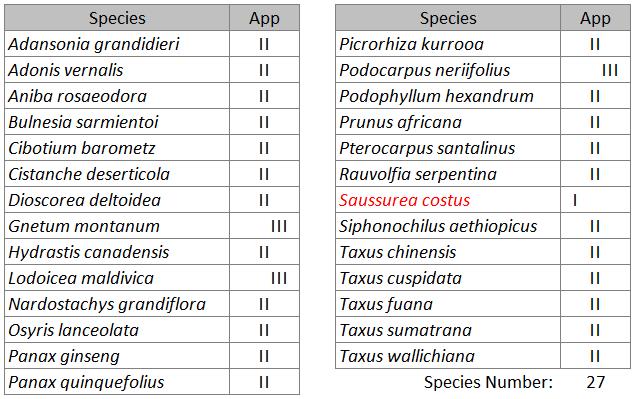Twenty-seven species were included in the CITES Appendices as individual species because the international trade in these medicinal plants raised conservation concerns. Additional significantly traded medicinal plants can be found in the Appendices as members of families or genera which were originally listed as ornamental plants.
Plant use groups in CITES
CITES entered into force in 1976. In the first decades its plant focus was on the horticultural trade, responding to conservation concerns that international trade in wild-collected orchid and cacti species was threatening their survival in the wild. As a consequence complete families such as Orchidaceae and Cactaceae were included in Appendix II. The rationale behind higher taxon listing was the belief that identification of traded plants would be made easier for customs officials by including larger and hence more easily recognizable plant groups.
It was not until the early 1990s that CITES took a closer look at the international trade in commodities such as timber and medicinal plants. However, during this time, CITES Parties no longer supported the inclusion of large groups of plants in the Appendices. This is one of the reasons why ornamental plants far outweigh other groups in the CITES Appendices. Table 1 shows the numbers of species in the three major use groups.
| Group | App. I | App. II | App. III |
| Medicinal plants | 1 | 130 | 3 |
| Ornamental plants | 390 | 32.102 | 105 |
| Timber species | 6 | 599 | 5 |
How many medicinal plants included in CITES?
Medicinal plants have entered the CITES Appendices in three different ways:
Twenty seven species were included as individual species because the international trade in these medicinal plants raised conservation concerns. Only one of these is listed in Appendix I: Saussurea costus. Three species are listed in Appendix III. The remaining species are listed in CITES Appendix II (Table 2).
In four cases, entire genera were included in Appendix II due to their overuse in the medicinal plant trade (Table 3). Important species from these groups that are internationally traded as medicinal plants are, for example, Aquilaria malaccensis and Hoodia gordonii.
| Higher taxon listing | Appendix | Number of species |
| Aquilaria spp. | II | 29 |
| Gyrinops spp. | II | 9 |
| Hoodia spp. | II | 12 |
| Rhodiola spp. | II | 58 |
The plants in Tables 2 and 3 were CITES listed due to their use as medicinals. However, significantly traded medicinal plant species can also be found in families or genera originally listed as ornamental plants. Examples include the orchid species Dendrobium nobile, Gastrodia elata and Bletilla striata which all play a major role in Traditional Chinese Medicine (Table 4).
| Higher taxa | App. | Use focus | Significantly traded medicinal plant species |
| Orchidaceae spp. | II | Ornamental | Dendrobium nobile , Gastrodia elata, or Bletilla striata |
| Aloe spp. | II | Ornamental | Aloe ferox |
| Euphorbia spp. | II | Ornamental | Euphorbia antisyphilitica |
| Guaiacum spp. | II | Timber | Guaiacum sanctum |
When the species, genera and families listed in the CITES Appendices are cross-checked with the MAPROW database, one finds more than 1,000 medicinal plant species that would be subject to CITES protection and control if they were to enter international trade.
_______________________________
by Uwe Schippmann, 19.2.2023

